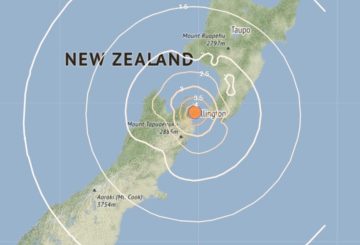Si Raukura Chankee-Paea (kaliwa) at Meadow Hussey (kanan) ay nakatanggap ng Rangatahi award.
Ang mga mag-aaral mula sa isang paaralan sa Wellington ay gumagamit ng wika at kaalaman ng Maori upang maprotektahan ang mga mahahalagang site at turuan ang mga bisita tungkol sa kanilang lokal na lugar. Ang natatanging negosyong ito, na sinimulan ng mga mag-aaral mula sa Te Kura Kaupapa Maori o nga Mokopuna noong 2021, ay gumagabayan sa mga bisita sa paligid ng lugar ng Maraenui (Seatoun), na nagbabahagi ng mga kwento at kasaysayan ng mga lugar sa kahabaan ng baybayin.
Ang kanilang negosyo, si Ngā Tapuwae a-Taraika, ay nanalo ng Rangatahi award sa Ngā Tohu Reo Maori 2024. Nakakaakit ito ng iba’t ibang mga bisita, kabilang ang mga mag-aaral mula sa ibang mga paaralan at mga miyembro ng Wētā FX Team.
Habang nakatayo sa beach sa harap ng kanilang paaralan, itinuturo ng mga senior student na si Raukura Chankee-Paea at Meadow Hussey ang ilan sa mga makasaysayang lugar sa lugar. Ang isa sa gayong site ay ang Te Tūranga o Kupe, isang bato na nagmamarka ng unang lugar na itinakda ng maalamat na explorer na Kupe sa rehiyon.
Ang kanilang negosyo ay pinangalanan sa ninuno na si Taraika, ngunit sinabi ni Meadow na si Kupe ang ninuno na madalas na tinalakay sa kanilang mga kwento. Kinikilala si Kupe sa pagpangalan ng mga isla sa Wellington Harbour, Matiu (Somes Island), Mākaro (Ward Island) at Mokopuna.
Itinuro ni Raukura ang lugar ng kung ano ang dating pinakamalaking Pā (pinatibay na nayon ng Maori) sa lugar, ang Whetukairangi, na ngayon ang lugar ng Worser Bay School. Sinabi niya na ang paboritong bahagi niya ng paglilibot ay kapag dalhin nila ang mga bisita upang tingnan kung saan tumama ng barkong Wahine ang Te Tangihanga a Kupe (Barrett Reef).
Sinabi ni Meadow na may responsibilidad silang matiyak na hindi nakalimutan ang mga kasaysayan na ito, kaya’t gusto niyang makita kapag natututo ng bago ang kanilang mga bisita. Idinagdag ni Raukura na para sa marami sa kanilang mga bisita, kahit na ang mga lumaki sa Wellington, ito ang unang pagkakataon na narinig nila ang tungkol sa mga lugar na ito. Ngunit sinabi niya iyon na nangangahulugan na maaari nilang ipasa ang mga kwento sa kanilang sariling pamilya at kaibigan.
Matapos manalo ang parangal, hinikayat ni Raukura ang mga tao ng Maori sa buong New Zealand na “hanapin ang lakas upang mababahan ang ating mundo ng wikang Maori at sa ating kaugalian.”




























































